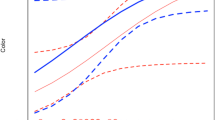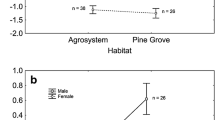Abstract
Organismal coloration is used for communication, camouflage, and thermoregulation. These functions of body coloration may impose conflicting demands upon color-changing organisms. Here, we examined interacting thermoregulatory and camouflage color change responses when fiddler crabs Uca panacea were subject to simultaneously changing temperatures (10, 25, 40 °C) and backgrounds (black, white). Crab coloration lightened on a white background and at high temperatures and darkened on a black background and at low temperatures, reflecting the camouflage and thermoregulatory functions of color change. Synergistic background and temperature treatments (i.e., hot/white or cold/black) induced strong color change responses. When temperature and background were in conflict (i.e., hot/black or cold/white), responses to background coloration constrained thermoregulatory color change such that carapace coloration did not change. Such conflicts are likely to be common in nature, especially in highly heterogeneous environments. Throughout the experiment, males remained lighter than females and showed a greater response to the hot/white treatment, driven by a stronger response to high temperatures. These differences may reflect the physiological, morphological, and behavioral differences associated with sexual selection and sexual dimorphism in this species.



Similar content being viewed by others
References
Allen BJ (2007) Costs of sexual selection in the sand fiddler crab, Uca pugilator. Ph.D. Dissertation, Stony Brook, New York
Barnwell FH, Thurman CL (1984) Taxonomy and biogeography of the fiddler crabs (Ocypodidae: Genus Uca) of the Atlantic and Gulf coasts of eastern North America. Zool J Linn Soc 81:23–87
Bildstein KL, McDowell SG, Brisbin IL (1989) Consequences of sexual dimorphism in sand fiddler crabs, Uca pugilator: differential vulnerability to avian predation. Anim Behav 37:133–139
Brown FA, Sandeen MI (1948) Responses of the chromatophores of the fiddler crab, Uca, to light and temperature. Physiol Zool 21:361–371
Campbell GS, Norman JM (1998) Introduction to environmental biophysics. Springer, New York
Caravello HE, Cameron GN (1987a) The effects of sexual selection on the foraging behavior of the Gulf Coast fiddler crab Uca panacea. Anim Behav 35:1864–1874
Caravello HE, Cameron GN (1987b) Foraging time allocation in relation to sex by the Gulf Coast fiddler crab Uca panacea. Oecologia 72:123–126
Caravello HE, Cameron GN (1991) Time activity budgets of the Gulf Coast fiddler crab Uca panacea. Am Midl Nat 126:403–407
Chiao C-C, Hanlon RT (2001) Cuttlefish cue visually on area, not shape or aspect ratio, of light objects in the substrate to produce disruptive body patterns for camouflage. Biol Bull 201:269–270
Christy JH, Backwell PRY, Goshima S, Kreuter T (2002) Sexual selection for structure building by courting male fiddler crabs: an experimental study of behavioral mechanisms. Behav Ecol 13:366–374
Clusella-Trullas S, Terblanche JS, Blackburn TM, Chown SL (2008) Testing the thermal melanism hypothesis: a macrophysiological approach. Funct Ecol 22:232–238
Couldridge VCK, Alexander GJ (2002) Color patterns and species recognition in four closely related species of Lake Malawi cichlid. Behav Ecol 13:59–64
Crane J (1975) Fiddler crabs of the world (Ocypodidae: genus Uca). Princeton University Press, Princeton
Croll GA, McClintock JB (2000) An evaluation of lekking behavior in the fiddler crab Uca spp. J Exp Mar Biol Ecol 254:109–121
Crothers L, Gering E, Cummings M (2011) Aposematic signal variation predicts male–male interactions in a polymorphic poison frog. Evolution 65:599–605
Cummings ME, Jordao JM, Cronin TW, Oliveira RF (2008) Visual ecology of the fiddler crab, Uca tangeri: effects of sex, viewer and background on conspicuousness. Anim Behav 75:175–188
Cuthill IC, Stevens M, Sheppard J, Maddocks T, Parraga CA, Troscianko TS (2005) Disruptive coloration and background pattern matching. Nature 434:72–74
Darnell MZ (2012) Ecological physiology of the circadian pigmentation rhythm in the fiddler crab Uca panacea. J Exp Mar Biol Ecol 426–427:39–47
Darnell MZ, Munguia P (2011) Thermoregulation as an alternate function of the sexually dimorphic fiddler crab claw. Am Nat 178:419–428
Darnell MZ, Fowler KK, Munguia P (2013) Sex-specific thermal constraints on fiddler crab behavior. Behav Ecol. doi:10.1093/beheco/art006
Detto T (2007) The fiddler crab Uca mjoebergi uses colour vision in mate choice. Proc R Soc B-Biol Sci 274:2785–2790
Detto T, Backwell PRY (2009) The fiddler crab Uca mjoebergi uses ultraviolet cues in mate choice but not aggressive interactions. Anim Behav 78:407–411
Detto T, Backwell PRY, Hemmi JM, Zeil J (2006) Visually mediated species and neighbour recognition in fiddler crabs (Uca mjoebergi and Uca capricomis). Proc R Soc B-Biol Sci 273:1661–1666
Detto T, Hemmi JM, Backwell PRY (2008) Colouration and colour changes of the fiddler crab, Uca capricornis: a descriptive study. PLoS ONE 3:e1629
Fleishman LJ, Leal M, Sheehan J (2006) Illumination geometry, detector position and the objective determination of animal signal colours in natural light. Anim Behav 71:463–474
Fletcher DJ, Underwood AJ (2002) How to cope with negative estimates of components of variance in ecological field studies. J Exp Mar Biol Ecol 273:89–95
Garcia TS, Sih A (2003) Color change and color-dependent behavior in response to predation risk in the salamander sister species Ambystoma barbouri and Ambystoma texanum. Oecologia 137:131–139
Godin J-GJ, McDonough HE (2003) Predator preference for brightly colored males in the guppy: a viability cost for a sexually selected trait. Behav Ecol 14:194–200
Guilford T (1988) The evolution of conspicuous coloration. Am Nat 131:S7–S21
Haskell DG (1996) Do bright colors at nests incur a cost due to predation? Evol Ecol 10:285–288
Heinen JT (1994) The significance of color change in newly metamorphosed American toads (Bufo a. americanus). J Herpetol 28:87–93
Hemmi JM, Marshall J, Pix W, Vorobyev M, Zeil J (2006) The variable colours of the fiddler crab Uca vomeris and their relation to background and predation. J Exp Biol 209:4140–4153
King RB, Hauff S, Phillips JB (1994) Physiological color change in the green tree frog: responses to background brightness and temperature. Copeia 1994:422–432
Koga T, Backwell PRY, Christy JH, Murai M, Kasuya E (2001) Male-biased predation of a fiddler crab. Anim Behav 62:201–207
Marshall NJ (2000) Communication and camouflage with the same ‘bright’ colours in reef fishes. Philos Trans R Soc Lond B Biol Sci 355:1243–1248
Merilaita S (1998) Crypsis through disruptive coloration in an isopod. Proc R Soc Lond B Biol Sci 265:1059–1064
Munguia P, Levinton JS, Silbiger NJ (2013) Latitudinal differences in thermoregulatory color change in Uca pugilator. J Exp Mar Biol Ecol 440:8–14
Norris KS (1967) Color adaptation in desert reptiles and its thermal relationships. In: Milstead WW (ed) Lizard ecology- a symposium. University of Missouri Press, Columbia, pp 162–229
O’Connor KI, Metcalfe NB, Taylor AC (1999) Does darkening signal submission in territorial contests between juvenile Atlantic salmon, Salmo salar? Anim Behav 58:1269–1276
Patterson HD, Thompson R (1971) Recovery of inter-block information when block sizes are unequal. Biometrika 58:545–554
Pope DS (2000) Testing function of fiddler crab claw waving by manipulating social context. Behav Ecol Sociobiol 47:432–437
Porter WP (1967) Solar radiation through the living body walls of vertebrates with emphasis on desert reptiles. Ecol Monogr 37:274–296
Powers LW (1975) Fiddler crabs in a nontidal environment. Contrib Mar Sci 19:67–78
Powers LW, Cole JF (1976) Temperature variation in fiddler crab microhabitats. J Exp Mar Biol Ecol 21:141–157
Rao KR (1985) Pigmentary effectors. In: Bliss DE, Mantel LH (eds) The biology of crustacea integuments, pigments, and hormonal processes. Academic Press, New York, pp 395–462
Rodrigues RR, Carvalho LN, Zuanon J, Del-Claro K (2009) Color changing and behavioral context in the Amazonian dwarf cichlid Apistogramma hippolytae (Perciformes). Neotrop Ichthyol 7:641–646
Silbiger N, Munguia P (2008) Carapace color change in Uca pugilator as a response to temperature. J Exp Mar Biol Ecol 355:41–46
Smith WK, Miller PC (1973) The thermal ecology of two South Florida fiddler crabs: Uca rapax Smith and U. pugilator Bosc. Physiol Zool 46:186–207
Stegen JC, Gienger CM, Sun LX (2004) The control of color change in the Pacific tree frog, Hyla regilla. Can J Zool 82:889–896
Stevens M, Merilaita S (2009) Animal camouflage: current issues and new perspectives. Philos Trans R Soc B Biol Sci 364:423–427
Stevenson RD (1985) The relative importance of behavioral and physiological adjustments controlling body temperature in terrestrial ectotherms. Am Nat 126:362–386
Stuart-Fox D, Moussalli A (2009) Camouflage, communication and thermoregulation: lessons from colour changing organisms. Philos Trans R Soc B Biol Sci 364:463–470
Stuart-Fox DM, Moussalli A, Marshall NJ, Owens IPF (2003) Conspicuous males suffer higher predation risk: visual modelling and experimental evidence from lizards. Anim Behav 66:541–550
Thurman CL (1984) Ecological notes on fiddler crabs of south Texas, with special reference to Uca subcylindrica. J Crust Biol 4:665–681
Thurman CL (1990) Adaptive coloration in Texas fiddler crabs (Uca). In: Wicksten M (ed) Adaptive coloration in invertebrates. Texas A&M University Sea Grant College Program, College Station
Thurman CL (2002) Osmoregulation in six sympatric fiddler crabs (genus Uca) from the northwestern Gulf of Mexico. Mar Ecol Prog Ser 23:269–284
Tullberg BS, Merilaita S, Wiklund C (2005) Aposematism and crypsis combined as a result of distance dependence: functional versatility of the colour pattern in the swallowtail butterfly larva. Proc R Soc B-Biol Sci 272:1315–1321
Vroonen J, Vervust B, Fulgione D, Maselli V, Van Damme R (2012) Physiological colour change in the Moorish gecko, Tarentola mauritanica (Squamata: Gekkonidae): effects of background, light, and temperature. Biol J Linn Soc 107:182–191
Walton BM, Bennett AF (1993) Temperature-dependent color change in Kenyan chameleons. Physiol Zool 66:270–287
Weis JS (1985) Cadmium acclimation and limb regeneration in the fiddler crab, Uca pugilator: sex differences. Mar Environ Res 16:199–214
Weissburg M (1993) Sex and the single forager: gender-specific energy maximization strategies in fiddler crabs. Ecology 74:279–291
Weissburg MJ, Derby CD (1995) Regulation of sex-specific feeding behavior in fiddler crabs: physiological properties of chemoreceptor neurons in claws and legs of males and females. J Comp Physiol A Neuroethol Sens Neural Behav Physiol 176:513–526
Wiernasz DC, Kingsolver JG (1992) Wing melanin pattern mediates species recognition in Pieris occidentalis. Anim Behav 43:89–94
Wilkens JL, Fingerman M (1965) Heat tolerance and temperature relationships of the fiddler crab, Uca pugilator, with reference to coloration. Biol Bull 128:133–141
Zeil J, Hofmann M (2001) Signals from ‘crabworld’: cuticular reflections in a fiddler crab colony. J Exp Biol 204:2561–2569
Acknowledgments
We would like to thank K. Darnell for her assistance in collecting crabs. M. Buckley, P. Gravinese, R. Tankersley, and A. Wassick provided comments and suggestions on an earlier version of this manuscript. S.M.K. was supported by the NSF Research Experiences for Undergraduates program.
Author information
Authors and Affiliations
Corresponding author
Additional information
Communicated by M. G. Chapman.
Rights and permissions
About this article
Cite this article
Kronstadt, S.M., Darnell, M.Z. & Munguia, P. Background and temperature effects on Uca panacea color change. Mar Biol 160, 1373–1381 (2013). https://doi.org/10.1007/s00227-013-2189-5
Received:
Accepted:
Published:
Issue Date:
DOI: https://doi.org/10.1007/s00227-013-2189-5




